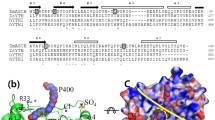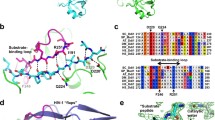Abstract
A DNA binding protein with an Mr of 11000 was purified fromUstilago maydis. Its solubility in acid, amino acid composition, and mobility during gel electrophoresis are reminiscent of properties observed for the high mobility group nonhistone chromosomal proteins. The protein recognizes cruciform DNA made from oligonucleotides and also binds preferentially to a plasmid containing an extruded cruciform.
Similar content being viewed by others
References
Bianchi M (1991) Production of functional rat HMG1 protein inEscherichia coli. Gene 104: 271–275
Bianchi M, Beltrame M, Paonessa G (1989) Specific recognition of cruciform DNA by nuclear protein HMG1. Science 243: 1056–1059
Birnboim HC, Doly J (1979) A rapid alkaline extraction procedure for screening recombinant plasmid DNA. Nucleic Acids Res 7: 1513–1523
Bonne C, Duguet M, de Recondo A-M (1980) Single-strand DNA binding protein from rat liver: interactions with supercoiled DNA. Nucleic Acids Res 8: 4955–4968
Bonne C, Sautiere P, Duguet M, de Recondo A-M (1982) Identification of a single-stranded DNA binding protein from rat liver with high mobility group protein 1. J Biol Chem 257: 2722–2725
Bustin M, Lehn DA, Landsman D (1990) Structural features of the HMG chromosomal proteins and their genes. Biochim Biophys Acta 1049: 231–243
Chem Sm, Heffron F, Leupin W, Chazin WJ (1991) Two-dimensional1H NMR studies of synthetic immobile Holliday junctions. Biochemistry 30: 766–771
Churchill MEA, Tullius TD, Kallenbach NR, Seeman NC (1988) A Holliday recombination intermediate is twofold symmetric. Proc Natl Acad Sci USA 85: 4653–4656
Cooper JP, Hagerman PJ (1987) Gel electrophoretic analysis of the geometry of a DNA four-way junction. J Mol Biol 198: 711–719
Cooper JP, Hagerman PJ (1989) Geometry of a branched DNA structure in solution. Proc Natl Acad Sci USA 86: 7336–7340
Cunningham RP, DasGupta C, Shibata T, Radding CM (1980) Homologous pairing in genetic recombination: recA protein makes joint molecules of gapped circular DNA and closed circular DNA. Cell 20: 223–235
Dixon DA, Kowalczykowski SC (1991) Homologous pairing in vitro stimulated by the recombination hospot, Chi. Cell 66: 361–371
Duckett DR, Murchie AIH, Diekmann S, von Kitzing W, Kemper B, Lilley DMJ (1988) The structure of the Holliday junction and its resolution. Cell 55: 79–89
Duckett DR, Murchie AIH, Lilley DMJ (1990) The role of metal ions in the conformation of the four-way DNA junction. EMBO J 9: 583–590
Dunderdale HJ, Benson FE, Parsons CA, Sharples GJ, Lloyd RG, West SC (1991) Formation and resolution of recombination intermediates byE. coli RecA and RuvC proteins. Nature 354: 506–510
Elborough KM, West SC (1988) Specific binding of cruciform DNA structures by a protein from human extracts. Nucleic Acids Res 16: 3603–3616
Gellert M, O'Dea MH, Mizuuchi K (1983) Slow cruciform transitions in palindromic DNA. Proc Natl Acad Sci USA 80: 5545–5549
Giese K, Cox J, Grosschedl R (1992) The HMG domain of lymphoid enhancer factor 1 bends DNA and facilitates assembly of functional nucleoprotein structures. Cell 69: 185–195
Gough GW, Sullivan KM, Lilley DMJ, (1986) The structure of cruciforms in supercoiled DNA: probing the single-stranded character of nucleotide bases with bisulphite. EMBO J 5: 191–196
Gubbay J, Collingnon J, Koopman P, Capel B, Economou A, Musterberg A, Vivian N, Goodfellow P, Lovell-Badge R (1990) A gene mapping to the sex-determining region of the mouse Y chromosome is a member of a novel family of embryonically expressed genes. Nature 346: 245–250
Holliday R (1964) A mechanism for gene conversion in fungi. Genet Res 5: 282–304
Jantzen HM, Admon A, Bell SP, Tjian R (1990) Nucleolar transcription factor hUBF contains a DNA-binding motif with homology to HMG protein. Nature 344: 830–836
Javaherian K, Sadegi M, Liu LF (1979) Nonhistone proteins HMG1 and HMG2 unwind DNA double helix. Nucleic Acids Res 6: 3569–3580
Johns EW (1982) History, definition and problems. In: Johns EW (ed) The HMG chromosomal proteins. Academic Press, New York, pp. 1–7
Kallenbach NR, Ma RI, Seeman NC (1983) An immobile nucleic acid junction constructed from oligonucleotides. Nature 305: 829–831
Kmiec E, Holloman WK (1982) Homologous pairing of DNA molecules promoted by a protein fromUstilago. Cell 29: 367–374
Kmiec E, Holloman WK (1986) Homologous pairing of DNA molecules byUstilago rec1 protein is promoted by sequences of Z-DNA. Cell 44: 545–554
Kolodrubetz D, Burgum A (1990) DuplicatedNHP6 genes ofSacharomyces cerevisiae encode proteins homologous to bovine high mobility group protein 1. J Biol Chem 265: 3234–3239
Kruger W, Herskowitz I (1991) A negative regulator of HO transcription,SIN1 (SPT2), is a nonspecific DNA-binding protein related to HMG1. Mol Cell Biol 11: 4135–4146
McEntee K, Weinstock GM, Lehman IR (1980) Initiation of general recombination catalyzed in vitro by the recA protein ofE. coli. Proc Natl Acad Sci USA 77: 857–861
Murchie AIH, Clegg RM, von Kitzing E, Duckett DR, Diekmann S, Lilley DMJ (1989) Fluorescence energy transfer shows that the four-way DNA junction is a right-handed cross of antiparallel molecules. Nature 341: 763–766
Parsons CA, Tsaneva I, Lloyd RG, West SC (1992) Interaction ofEscherichia coli RuvA and RuvB proteins with synthetic Holliday junctions. Proc Natl Acad Sci USA 89: 5452–5456
Peterson CL, Kruger W, Herskowitz I (1991) A functional interaction between the C-terminal domain of RNA polymerase II and the negative regulatorSIN1. Cell 64: 1135–1143
Radding CM (1991) Helical interactions in homologous pairing and strand exchange driven by RecA protein. J Biol Chem 266: 5355–5358
Roeder GS, Beard C, Smith M, Keranen S (1985) Isolation and characterization of theSPT2 gene, a negative regulator of Tycontrolled yeast gene expression. Mol Cell Biol 5: 1543–1553
Seeman NC, Kallenbach NR (1983) Design of immobile nucleic acid junctions. Biophys J 44: 201–209
Shiba T, Iwasaki H, Nakata A, Shinagawa H (1991) SOS-inducible DNA repair proteins, RuvA and RuvB, ofEscherichia coli: Functional intermediates between RuvA and RuvB for ATP hydrolysis and renaturation of the cruciform structure in supercoiled DNA. Proc Natl Acad Sci USA 88: 8445–8449
Singh J, Dixon GH (1990) High mobility group proteins 1 and 2 function as general class II transcription factors. Biochemistry 29: 6295–6302
Smith GR (1990) RecBCD enzyme. In: Eckstein F, Lilley DMJ (eds) Nucleic acids and Molecular Biology 4. Springer, Berlin, pp. 78–98
Sugimoto A, Iino Y, Maeda T, Watanabe Y, Yamamoto M (1991)Schizosaccharomyces pombe stell + encodes a transcription factor with an HMG motif that is a critical regulator of sexual development. Genes Dev 5: 1990–1999
Symington L, Kolodner R (1985) Partial purification of an enzyme fromSaccharomyces cerevisiae that cleaves Holliday junctions. Proc Natl Acad Sci USA 82: 7247–7251
Takahagi M, Iwasaki H, Nakata A, Shinagawa H (1991) Molecular analysis of theEscherichia coli ruvC gene which encodes a Holliday junction-specific endonuclease. J Bacteriol 173: 5747–5753
Travis A, Amsterdam A, Belanger C, Grosshedl R (1991) LEF-1 a gene encoding a lymphoid specific protein with an HMG domain, regulates T-cell receptor alpha enhancer function. Genes Dev 5: 880–894
Tsaneva IR, Muller B, West SC (1992) ATP-dependent branch migration of Holliday junctions promoted by the RuvA and RuvB proteins ofE. coli Cell 69: 1171–1180
van de Sande JH, Kleppe K, Khorana HG (1973) Reversal of bacteriophage T4 induced polynucleotide kinase action. Biochemistry 12: 5050–5055
van de Wetering M, Oosterwegel M, Dooijes D, Clevers H (1991) Identification and cloning of TCF-1, a T-lymphocyte-specific transcription factor containing a sequence specific HMG box. EMBO J 10: 123–132
Waga S, Mizuno S, Yoshida M (1990) Chromosomal protein HMG1 removes the transcriptional block caused by the cruciform in supercoiled DNA. J Biol Chem 265: 19424–19428
Warren GJ, Green RL (1985) Comparison of physical and genetic properties of palindromic DNA sequences. J Bacteriol 161: 1103–1111
Weber S, Isenberg I (1980) High mobility group proteins ofSaccharomyces cerevisiae. Biochemistry 19: 2236–2240
Wemmer DE, Wand AJ, Seeman NC, Kallenbach NR (1985) NMR analysis of DNA junctions: imino proton NMR studies of individual arms and intact junction. Biochemistry 24: 5745–5749
West SC (1992) Enzymes and molecular mechanisms of genetic recombination. Annu Rev Biochem 61: 603–640
Author information
Authors and Affiliations
Additional information
Communicated by: P.B. Moens
Rights and permissions
About this article
Cite this article
Kotani, H., Kmiec, E.B. & Holloman, W.K. Purification and properties of a cruciform DNA binding protein fromUstilago maydis . Chromosoma 102, 348–354 (1993). https://doi.org/10.1007/BF00661278
Received:
Revised:
Accepted:
Issue Date:
DOI: https://doi.org/10.1007/BF00661278




